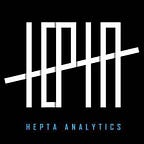Measuring the Accuracy of Machine Learning Models: Mean Absolute Error (MAE)
In writing this blog, I am sure I should have started from the basics of Machine learning such as talking about supervised or unsupervised models or training and testing data sets in Machine learning, but I feel this has been addressed a lot on this space and everyone has tried to use the available labelled data sets to create supervised machine learning models or the unlabeled data to find clusters in the data and association.
In this article, I will
be addressing the last but most important step when dealing with Machine
learning models, this is how you determine the accuracy of the machine Learning
models once you have implemented the model. This is very key because, if the
accuracy of the model is very low, there is a lot you have missed when fitting
the model regarding the dataset that you had. This mostly is underfitting which
occurs because of two major reasons
- The model fails to fit in the dataset
provided because it didn’t find any trend in the dataset - Fitting a model to the wrong data i.e.
fitting a linear model to a nonlinear data set.
Another major situation
that influence the accuracy of the model is overfitting in the training dataset.
This is mostly caused by the dataset having too many explanatory variables and
the model tries to incorporate every variable.
When you implement a
model, its essential to determine the accuracy before recommending the model to
be used in production. Below are some of the metrics that you can use when it
comes to Machine Learning. I will be explaining all the metrics in layman’s
language and where mostly you can use them in a series of articles. In this
article, the focus will be MAE.
- Mean Absolute Error
- Mean Absolute Percentage Error
- Mean Squared Error
- R squared
- Confusion Matrix
Mean
Absolute Error
As the name suggest, the
metric is mostly focused on the errors. This means the difference between the actual
observation and the predicted observation. MAE is mostly used to evaluate
regression models such as linear models. Basically, all the observations are in
continuous form. To implement it in any language, it follows the logic below in
the order of the steps.
- Getting the Error, Error = Actual observation — predicted observation
- When you get all the errors, you will
realize that some errors are positive, and others are negative - Getting the Absolute Error = |Error|
- This step ignores the sign before the
error. Treating the positive and negative errors observed as absolute - Getting the Average (Mean) of the absolute errors
- This involves adding all the errors and
dividing with the total number of observations.
Practical
Example predicting the price of Houses:
House
description Predicted
cost of the house using Linear Model Actual
cost of the house Calculating
the error (Actual -Predicted) Absolute
Error 2
bedroom, 2 baths, kitchen and balcony $18700 $20000 +1300 1300 3-bedroom,
kitchen, 2 bath, dry cleaner, gas cooker $43,200 $40000 -3200 3200 3-bedroom,
kitchen, 3 baths, $27,800 $30000 +2200 2200 4
bedroom, 2 baths, dish washer, dry cleaner, kitchen, dry cleaner $63200 $58000 -5200 5200 2-bedroom,
dry cleaner, electric cooker, dish washer $22400 $25000 +2600 2600
Getting the Average of
the Absolute errors:
1300 +3200+2200+5200+2600
= 14500
14500/5 = 2900
Interpreting
MAE results:
- The result can range from 0 to infinity
- MAE result is not affected by the
direction of errors since we use absolute errors - The lower the result the better
- A MAE of $2900 is our measure
of our Model quality which means our that on Average our model predictions are
off with approximately $2900
Analyzing
MAE:
As much as MAE takes care
of all the errors across the predicted values, it gives all the errors the same
weight (small and big errors). This means missing the right prediction by 5 is
as bad as missing the right prediction by 1. If missing the right value by 5 is
way worse than missing by 1, consider using MAPE since it takes into consideration
the weight of the errors. (will be explored in the next article).
MAE is best used in
scenarios where the magnitude of every error is not important.
Point
to Note:
In case one avoids
the second step, of getting the absolute and uses the raw errors to calculate
the Mean, the result is described as Mean
Bias Error. This measures the average bias in the model itself. Which means,
how is our model biased in comparison to the actual predictions. Sometimes it can
give weird result, since most of the time, the positives and negatives will
cancel out. Should be careful when interpreting the results.
